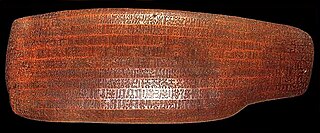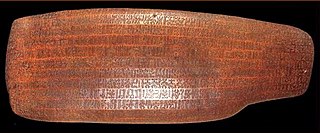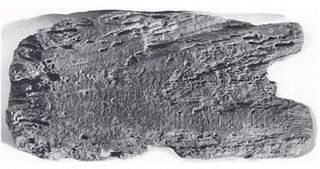
Text G of the rongorongo corpus, the smaller of two tablets located in Santiago and therefore also known as the Small Santiago tablet, is one of two dozen surviving rongorongo texts. It may include a short genealogy.

Text G of the rongorongo corpus, the smaller of two tablets located in Santiago and therefore also known as the Small Santiago tablet, is one of two dozen surviving rongorongo texts. It may include a short genealogy.
G is the standard designation, from Barthel (1958). Fischer (1997) refers to it as RR8.
Museo Nacional de Historia Natural, Santiago. Catalog # 5.497 (314).
There are reproductions at the Musée de l'Homme, Paris; Padri dei Sacri Cuori (SSCC), Rome; Museum of Mankind, London; Ibero-American Institute, Berlin; Bishop Museum, Honolulu; Department of Anthropology, National Museum of Natural History, Smithsonian Institution, Washington; American Museum of Natural History, New York; van Hoorebeeck Collection, Belgium; and in Steven Fischer's collection in Auckland.

A beautiful fluted tablet in excellent condition, 32 × 12.1 × 1.8 cm, of Pacific rosewood (Orliac 2005).
In 1870 Father Roussel gave tablets G and H to Captain Gana of the Chilean corvette O'Higgins. They remained in the custody of the Chilean navy in Valparaíso until they were sent to the newly established department of archeology at the Museo Nacional de Historia Natural.[ citation needed ]
In 1956 Butinov and Knorozov noted that the structure of a sequence of 15 glyphs in Gv6 suggested that it was a genealogy: A son of B, B son of C, C son of D, ... The final glyph 76 in each sequence, which Fischer (1997) sees as a phallus, would thus be a patronymic taxogram and would mark personal names on other tablets, something which Guy (1998) considers to be a reasonable interpretation.
Several scholars have noticed that tablet G contains two structurally very different texts. Most of Gr is paraphrased as text K, while the last line and a half of Gr and the whole of Gv share short phrases with I and T (or at least Ta) but not the rest of the rongorongo corpus (Pozdniakov 1996:290, 299).
Eight lines of glyphs on each side, for ~ 720 glyphs in all.
Harrison (1874:379) noticed that lines Gr3-7 feature a compound glyph, 380.1+3 (a figure on a vertical rod with a garland), repeated 31 times, each followed by up to half a dozen glyphs before the next. He thought that the figure broke the text into sections, each of which contained the name of a chief. Fischer agrees that the appear to be names, and Guy (2001) identifies the garland as a determinative of royalty.
Most of the recto (lines 1-7) is repeated with little change on the younger London tablet; after this the structure of the text changes radically, making the last line and a half of Gr and the whole side of Gv distinct from the rest of the rongorongo corpus. In addition, Pozdniakov found a brief sequence of glyphs that crosses from Gr8 to Gv1, confirming Barthel's reading order.





Rongorongo is a system of glyphs discovered in the 19th century on Rapa Nui that appears to be writing or proto-writing. Numerous attempts at decipherment have been made, with none being successful. Although some calendrical and what might prove to be genealogical information has been identified, none of these glyphs can actually be read. If rongorongo does prove to be writing and proves to be an independent invention, it would be one of very few independent inventions of writing in human history.

Rongorongo is a system of glyphs discovered in the 19th century on Easter Island that appears to be writing or proto-writing. Text A of the rongorongo corpus, also known as Tahua, is one of two dozen surviving texts.

Rongorongo is a system of glyphs discovered in the 19th century on Easter Island that appears to be writing or proto-writing. Text B of the rongorongo corpus, also known as Aruku Kurenga, is one of two dozen surviving rongorongo texts.
Text C of the rongorongo corpus, also known as Mamari, is one of two dozen surviving rongorongo texts. It contains the Rapa Nui calendar.

Rongorongo is a system of glyphs discovered in the 19th century on Easter Island that appears to be writing or proto-writing. Text D of the rongorongo corpus, also known as Échancrée ("notched"), is one of two dozen surviving texts. This is the tablet that started Jaussen's collection.

Rongorongo is a system of glyphs discovered in the 19th century on Easter Island that appears to be writing or proto-writing. Text E of the rongorongo corpus, also known as Keiti, is one of two dozen known rongorongo texts, though it survives only in photographs and rubbings.

Text H of the rongorongo corpus, the larger of two tablets located in Santiago and therefore also known as the Great or Large Santiago tablet, is one of two dozen surviving rongorongo texts, and one of three recording the so-called "Grand Tradition".
Text N of the rongorongo corpus, the smaller of two tablets in Vienna and therefore also known as the Small Vienna tablet, is one of two dozen surviving rongorongo texts. It repeats much of the verso of tablet E.
Text Q of the rongorongo corpus, the smaller of two tablets in St. Petersburg and therefore also known as the Small St Petersburg tablet, is one of two dozen surviving rongorongo texts, and one of three recording the so-called "Grand Tradition".
Text P of the rongorongo corpus, the larger of two tablets in St. Petersburg and therefore also known as the Great or Large St Petersburg tablet, is one of two dozen surviving rongorongo texts, and one of three recording the so-called "Grand Tradition".

Text R of the rongorongo corpus, the smaller of two tablets in Washington and therefore also known as the Small Washington tablet, is one of two dozen surviving rongorongo texts.

Text S of the rongorongo corpus, the larger of two tablets in Washington and therefore also known as the Great or Large Washington tablet, is one of two dozen surviving rongorongo texts.

Rongorongo is a system of glyphs discovered in the 19th century on Easter Island that appears to be writing or proto-writing. Text F of the rongorongo corpus, also known as the (Stephen) Chauvet tablet, is one of two dozen surviving texts.
Text K of the rongorongo corpus, also known as the (Small) London tablet, is one of two dozen surviving rongorongo texts. It nearly duplicates the recto of tablet G.
Text T of the rongorongo corpus, also known as Honolulu tablet 1 or Honolulu 3629, is the only fluted tablet in the Honolulu collection and one of two dozen surviving rongorongo texts.
Text U of the rongorongo corpus, carved on a beam, also known as Honolulu tablet 2 or Honolulu 3628, is one of two dozen surviving rongorongo texts.

Text L of the rongorongo corpus, also known as (London) reimiro 2, is the smaller of two inscribed reimiro in London and one of two dozen surviving rongorongo texts.

Text M of the rongorongo corpus, the larger of two tablets in Vienna and therefore also known as the Large or Great Vienna tablet, is one of two dozen surviving rongorongo texts.

There have been numerous attempts to decipher the rongorongo script of Easter Island since its discovery in the late nineteenth century. As with most undeciphered scripts, many of the proposals have been fanciful. Apart from a portion of one tablet which has been shown to deal with a lunar calendar, none of the texts are understood, and even the calendar cannot actually be read. The evidence is weak that rongorongo directly represents the Rapa Nui language – that is, that it is a true writing system – and oral accounts report that experts in one category of tablet were unable to read other tablets, suggesting either that rongorongo is not a unified system, or that it is proto-writing that requires the reader to already know the text. Assuming that rongorongo is writing, there are three serious obstacles to decipherment: the small number of remaining texts, comprising only 15,000 legible glyphs; the lack of context in which to interpret the texts, such as illustrations or parallel texts which can be read; and the fact that the modern Rapa Nui language is heavily mixed with Tahitian and is unlikely to closely reflect the language of the tablets—especially if they record a specialized register such as incantations—while the few remaining examples of the old language are heavily restricted in genre and may not correspond well to the tablets either.

Irina Konstantinovna Feodorova was a Soviet historian. Her field of expertise was the ethnography, culture, folklore and language of the people of East Polynesia. Feodorova was doctor of historical sciences and a leading scientist of the Department of Australia, Oceania and Indonesia at the Museum of Anthropology and Ethnography at the Kunstkamera, St. Petersberg, the first Russian museum that was named after Peter the Great. In 1981, Feodorova was given the honour of being named N. N. Miklouho-Maclay Laureate of the Presidium of the Russian Academy of Science.